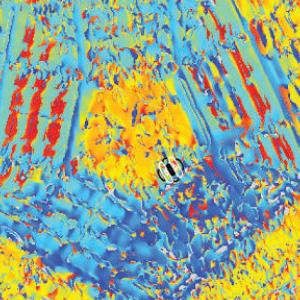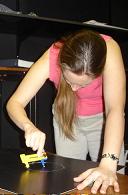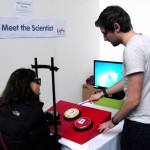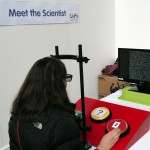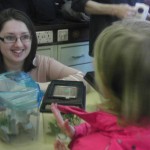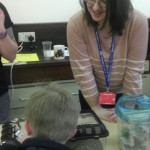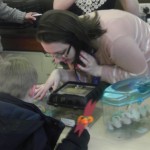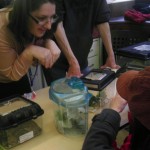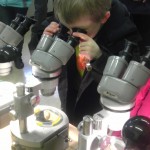There is an old Hungarian saying: ‘A puding próbája az evés’. That is, the only way to see if your pudding (as in dish) is any good, is to eat it. Well, we had our very long, very detailed pudding (as in dessert) today, and it was great! And believe me, we went down to the bottom!
Monthly Archives: March 2013
Zoltan’s diary: Monday 25/03/2013
Finally got the gadget to work. Tested against the results I managed to get earlier, and it seems to hold.
Since I am just about to finish this project (well, at least, time is up), it’s worth taking a look back: After fixing some experimental design issues, I got some wacky results. “Now that’s strange” I thought, and remained quite sceptical. It seemed so unrealistic, as the hypothesis was so straightforward that I was convincing that I will get the boring results everyone expected.
The results were nothing like it when I make the processing routines of course. What do you do in that case? You immediately assume that you have made a mistake at some point, and you have a list of suspected things you think might be held responsible. However, the results held against my every attempt to prove them inconsistent/wrong, and believe me, Jenny’s ‘vicious reviewer’ comments and my critical thinking made us to examine things thoroughly and systematically eliminate every factor that might have explained what we have seen or measured.
Today, I can say, that this three-week-long full-blown crusade against errors, mistakes and misinterpretations has failed. Going through thousands of measurements, quite a few display devices and even creating and using a purpose-built visual device (I couldn’t find an other name for it) have failed to do any harm to the credibility of the results.
end of line
Zoltan’s diary: Thursday 21/03/2013
After some fiddling with the code, the circuit works. Delays seem to be fine. Results seem to be fine. Found out how to control the serial port. I should upload some shell scripts to make life easier when using a campus pc. I managed to cover up the effect of the earth loops, so the circuit is stabilised properly.
Now, it’s on to matlab, and will need to spend time thinking about the implementation.
Zoltan’s diary: Wednesday 20/03/2013
Things now slow down a bit. I expected much more rapid progress with the micro. There were some obstacles that should not have been obstacles: The default reset value for an output pin is analogue input (took a good 3-4 hours to find out). My new USB/TTL UART doesn’t have the CTS/RTS pins wired internally to the power supply, so I can’t bypass flow control that easily (2-3 hours). The battery lasts around 5 hours in the oscilloscope (2×1 hour break). The poor thing sometimes re-sets because of interference. This will be solved as soon as I get rid of all the earth loops caused by the programmer, the UART and the oscilloscope and power supply.
Good news is that current-mode PWM powered LEDs are very closely linear. I managed to find my components in the morning (well, the components found me, actually…)
Michael at Centre for Life
In February, physiology undergraduate Michael Widdall ran a “Meet the Scientist” event at Newcastle’s Centre for Life, in which members of the public carried out a stereo psychophysics experiment.
Mantids meet the public at Moorbank Botanical Gardens
MRes/PhD student Lisa Hindmarsh ran a public engagement activity at the Open Day at Moorbank Gardens. Adults and children alike loved seeing the mantids, and using the microscopes to look at oothecae and other biological specimens.
- Lisa introduces young scientists to the mantids
- Lisa’s mantis impression at a public event
Zoltan’s diary: Friday 15/03/2013
The moral of today: One measurement is not a measurement. Practically the only two things I can do is to build the stimulator circuit and get an other photometer to make sure it’s not a calibration artifact. Then, all I can do is wash my hands how Pontius Pilate did. Then, I have locked out all possibility to have a misconducted measurement, and then, I can say is that my measurement is indeed correct no matter how wacky and unrealistic it seems. So the question is now if I have something publishable or more modest. Two weeks to go.
Proud PI
We just hosted a lab tour of shortlisted applicants to Newcastle’s Wellcome-Trust-funded 4-year neuroscience PhD theme. We only had half an hour, but in this time Paul, James, Zoltan, Parto and Lisa each gave a dynamic and lucid summary of their work, its motivation and important, and showed off their stimuli / insects / smartphones (delete as appropriate). On the way out one of the applicants said to me, “And what do YOU do?” I just waved a hand airily and said, “Oh, I supervise, you know…” Frankly with this team I’m fairly redundant but I like to think I look decorative.
Zoltan’s diary: Thursday 14/03/2013
The weird result I am seeing is not caused by the monitor. Also, it is not caused by the different refresh rate and stabilised plate current. I am getting the same things over and over again, and the test show that there is a significant deviation to what I was expecting. I can’t think of any other thing I might have missed, and the results are pretty consistent. I currently have 10 matlab figures open and can see the same pattern over and over again. Okay, the coefficients are different, but the other monitor is brighter, smaller and behaves differently.
To do an other verification, I will make a circuit, and will check it with LEDs as well. This tendency should vanish.
Zoltan’s diary: Tuesday 12/03/2013
Do you know what is the answer to the ultimate question of life, the universe and everything? If you say 42, well, you are at least as much of a nerd as I am.
I think I found today the psychophysics equivalent of it: 1.4142136. I don’t want to jump into conclusions, so I am doing extra verification, replacing displays, redoing experiments, so I can be a hundred zillion percent sure that it’s not there because I forgot something. Guess I will find out in the next few days.
Also, I had my arm zapped for a good 20 minutes. Georgia was astonished how fast I found the nerve in my arm to test a reflex. Weird.
